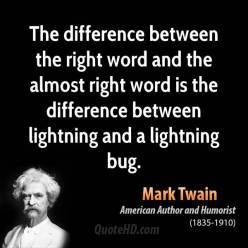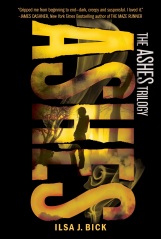 Mark Twain famously once said “the difference between the right word and the almost right word is really a large matter – it is the difference between the lightning and the lightning bug.”
Mark Twain famously once said “the difference between the right word and the almost right word is really a large matter – it is the difference between the lightning and the lightning bug.”
As writers it’s important to know that we’re more than storytellers, we are wordsmiths! Every word we type has potential to do more than convey character and plot. Our words can also deepen the mood and emotional resonance in our novels.
Ilsa J. Bick is a master of this technique. In her apocalyptic zombie novel, Ashes, Bick intensifies each page with the danger of her world through the use of aggressive words. In the following examples Bick uses the violent words of: slash, spear, and pierced, to describe otherwise peaceful images.
 “She registered the slash of morning sun in an already too-bright and very cold room…” (301).
“She registered the slash of morning sun in an already too-bright and very cold room…” (301).
“She heard the creak of Tom’s footsteps overhead, and a spear of light pierced the darkness as he shone his flashlight down the stairs” (159).
Bick’s words are doing double-duty. They not only convey the imagery and action of the scene but they also infuse each sentence with emotional stakes. Never once does Bick’s protagonist feel free of the horror that surrounds her. This is because Bick allows her powerful word choices to accumulate over the entire novel, creating an air of danger that is unconsciously felt by the reader.
Two Great Exercises to Learn How to Do This Yourself:
Exercise #1: Scene Analysis
Pick a scene in a book where you (as reader) felt an emotional connection. Perhaps this was a scene that made you cry, or cringe, or got your blood pumping. Re-read the scene and pick out the words that relate to the emotion you felt. Take a look at those words and how they’re used. Become aware of when a specific word choice affected you unconsciously!
Exercise #2: Write with Word Lists
A great way to use this technique in your own work is to create word-lists. Ask yourself what the emotional mood of the scene you’re writing is (i.e. fear, nervousness, lust, etc.). Now write a list of words that invoke this feeling for you. For example, if the feeling is nervousness, my words list could include:
wobble
chatter
prickle
tremble
ice
upturn
squeamish
clench
As you go to write your scene, try to use some of your words. You don’t have to use all of them, and you will easily start to come up with new ones as you write. But when you’re done you’ll find a new emotional layer has been added to your work with the touch of a few carefully chosen words.
If you’re interested in word choice and the use of language, also check out these great articles:
This article was originally published on THE PARKING LOT CONFESSIONAL in 2011.



I know we’ve talked about word lists before, but I’ve still never done it. I’m gonna have to try it sometime!
Aggressive words. I love that!!! I need to do this. And why have I missed this book??? I will rectify that immediately.